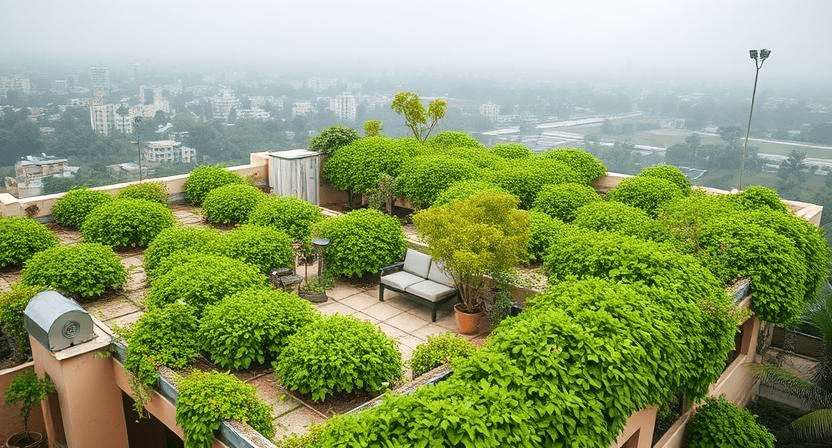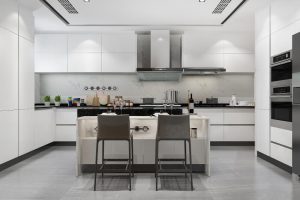As cities expand and environmental concerns grow, India is seeing a rise in green buildings. These are structures designed to use natural resources wisely, reduce pollution, and support healthier lifestyles. Whether you’re building a home, office, or commercial space, green buildings are the future of construction.
Let’s understand what makes a building “green”, what features are included, and how it benefits you and the environment.
What is a Green Building?
A green building is designed and built in a way that reduces its impact on the environment throughout its life cycle. From construction to operation, it focuses on energy saving, water efficiency, use of sustainable materials, and indoor environmental quality.
It’s not just about adding a solar panel or a garden on the roof. A true green building combines smart planning, technology, and materials to create long-term savings and comfort.
Green Buildings Features in India
1. Energy Efficiency
Green buildings are designed to consume less electricity. This is done by:
Using LED lighting instead of traditional bulbs, which use less power and last longer.
Installing energy-efficient appliances such as refrigerators, fans, air conditioners, and water heaters.
Using solar panels to generate clean, renewable energy from the sun.
Improving insulation in walls, roofs, and windows to keep the building cool in summer and warm in winter, reducing the need for air conditioning or heaters.
Maximizing natural daylight through proper window placement and skylights, so less artificial lighting is needed during the day.
This not only helps the environment but also reduces electricity bills over time.
2. Water Conservation
Water is a precious resource in India, and green buildings are designed to save as much as possible by:
Rainwater harvesting systems that collect and store rainwater for later use, like watering plants or flushing toilets.
Water-efficient plumbing fixtures, such as low-flow taps and showerheads, which reduce water use without affecting comfort.
Dual-flush toilets, which give the option to use less water for flushing when needed.
Greywater recycling systems, which clean used water from sinks, showers, or laundry and reuse it for gardening or flushing.
These methods reduce water bills and help in areas facing water shortages.
3. Use of Eco-Friendly Materials
Green buildings use building materials that are less harmful to the environment and healthier for people, such as:
Fly ash bricks, which are made from industrial waste and reduce the use of clay.
Bamboo, a fast-growing renewable material, used for flooring, walls, and furniture.
Recycled metals and wood, which lower the demand for new raw materials.
Low-VOC paints, which release fewer harmful chemicals into the air and are safer for indoor use.
By using these materials, green buildings reduce pollution, waste, and the strain on natural resources.
4. Better Indoor Air Quality
Green buildings are built to improve the air inside the home or office, which directly affects health. This is achieved by:
Proper ventilation systems that bring in fresh air and remove stale air, moisture, and pollutants.
Using non-toxic or low-VOC materials, such as paints, adhesives, and finishes that don’t release harmful gases.
Natural lighting and airflow, which not only saves energy but also boosts mental and physical well-being.
Good indoor air quality is especially important in cities where outdoor pollution levels are high.
5. Waste Management
Green buildings aim to reduce waste right from the construction phase and continue good practices during daily use. This includes:
Sorting construction waste so that materials like metal, wood, and concrete can be reused or recycled instead of sent to landfills.
Composting organic waste like food scraps and garden waste.
Providing space for recycling paper, plastic, and glass in homes and offices.
Using modular construction methods that produce less waste compared to traditional building techniques.
Effective waste management lowers the environmental impact and keeps surroundings cleaner.
Benefits Green Building
1. Cost Savings
Although green buildings may cost a little more to build at first, they save money in the long run. This is because:
They use less electricity, thanks to energy-efficient lighting, appliances, and solar power.
They use less water, through rainwater harvesting and low-flow fixtures.
Maintenance costs are lower because green buildings are designed to last longer and operate more efficiently.
Over time, these savings can more than make up for the initial investment.
2. Healthier Living
Green buildings are healthier for people living or working inside them. This is because they have:
Better indoor air quality, with proper ventilation and low-pollution materials.
Natural lighting, which reduces eye strain and improves mood and productivity.
Non-toxic paints and finishes, which reduce exposure to harmful chemicals.
This leads to fewer health problems such as allergies, headaches, or breathing issues—especially important for children, elderly people, and those with health conditions.
3. Environmental Protection
Green buildings help reduce the damage to the environment by:
Lowering carbon emissions through reduced energy use.
Conserving water resources with smart plumbing and rainwater harvesting.
Using eco-friendly materials that cause less pollution during production and disposal.
This helps fight climate change, reduce air and water pollution, and protect ecosystems.
4. Increased Property Value
As more people become aware of climate change and the benefits of sustainable living, green buildings are in demand. Because of this:
Green-certified homes and offices can sell for a higher price.
They attract more buyers or tenants, especially environmentally conscious ones.
They are considered a long-term investment due to their durability and lower running costs.
This makes green buildings a smart financial choice as well.
5. Government Support
To encourage green construction, the Indian government offers several benefits:
Tax rebates on property tax or income tax for green-certified buildings.
Faster approval of building plans and clearances for projects that follow green norms.
Incentives and subsidies for using solar panels, rainwater harvesting, or energy-saving equipment.
These policies make it easier and more affordable to build green, especially in urban areas where sustainability is urgently needed.
Importance of Green Buildings in India
Why Green Buildings Matter in India
India is one of the fastest-growing countries in the world. While this growth brings progress, it also creates serious environmental problems. These include:
Water scarcity in many regions, especially during summer or drought conditions
Air pollution in cities, affecting the health of millions
Energy shortages, leading to frequent power cuts and overuse of fossil fuels like coal and oil
Green buildings help solve these problems in a practical and long-lasting way.
How Green Buildings Help
Reduce Use of Natural Resources
Green buildings are designed to use less electricity, less water, and fewer raw materials. This reduces pressure on the environment and helps conserve what we have for future generations.Lower Pollution Levels
With better indoor air quality and less reliance on polluting energy sources, green buildings contribute to cleaner air both inside and outside.Save Energy and Water
By using smart technology and efficient systems, green buildings save energy and water every day. This helps cities manage growing populations without running out of essential resources.Support National Goals
India has committed to fighting climate change and achieving sustainable development through international agreements like the Paris Climate Accord. Green buildings are a major part of meeting these goals.
A Sustainable Future for India
With more people moving to cities, the demand for housing, offices, and infrastructure is growing rapidly. If this demand is met using traditional construction methods, the environmental damage will be massive.
Green buildings offer a solution that balances growth with responsibility. They allow us to build the homes and cities we need without harming the planet.
In short, building green is not just a good idea it’s the need of the hour for a cleaner, safer, and more sustainable India.
Ready to Build a Greener Future?
If you’re planning to build or renovate, consider going green. At SmartScale House Design, we specialize in eco-friendly home designs tailored for Indian conditions. From energy-efficient layouts to water-saving plans, we help you design a space that’s sustainable and cost-effective.
Let’s build smart. Let’s build green.
Contact SmartScale today for personalized green building solutions that work for your plot, budget, and lifestyle.
FAQs
1. What are the 7 components of a green building?
The 7 key components that make a building “green” are:
Sustainable Site Planning – Choosing the right location and minimizing environmental impact during construction.
Water Efficiency – Reducing water use through rainwater harvesting, low-flow fixtures, and greywater recycling.
Energy Efficiency – Lowering energy consumption using solar panels, energy-efficient lighting, and appliances.
Material Efficiency – Using recycled, non-toxic, and locally available building materials.
Indoor Environmental Quality – Improving air quality, ventilation, natural lighting, and thermal comfort.
Waste Reduction – Minimizing construction and household waste through recycling and proper waste management.
Operation and Maintenance Optimization – Ensuring the building continues to perform efficiently over time.
2. What are the four possible features of a green building?
Four common features of a green building include:
Energy-saving systems like LED lights and solar power
Water-saving systems such as rainwater harvesting and dual-flush toilets
Use of eco-friendly materials like fly ash bricks and bamboo
Healthy indoor environment with proper ventilation and non-toxic materials
These features work together to reduce environmental impact and improve the quality of life for the occupants.
3. What is green building and its benefits?
A green building is a structure that is planned, built, and operated in a way that reduces its impact on the environment and improves the well-being of people inside.
Benefits of green buildings include:
Lower electricity and water bills
Healthier indoor living environment
Less pollution and carbon emissions
Higher resale value of property
Support from government in the form of incentives and faster approvals
4. What is green building concept and its benefits?
The green building concept is about designing and constructing buildings that are environmentally responsible and resource-efficient throughout their life cycle—from design and construction to operation and maintenance.
Benefits of this concept include:
Efficient use of natural resources
Reduced environmental damage
Lower operating costs
Healthier spaces for occupants
Long-term sustainability and resilience to climate change









